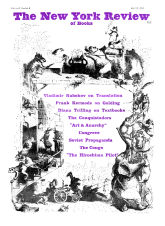In response to:
Pshaw! from the April 2, 1964 issue
To the Editors:
Marvin Mudrick has it that “Shaw continues to elude judicious criticism.” Mainly true, and in Mr. Mudrick’s review Shaw eludes criticism of any sort. To say that Shaw’s plays are to plays of Johnson, Wycherley, Congreve, and Wilde as nothing to something; to offer as almost the only support of the claim a bare catalogue of vices (“the prodigality of gab, the self-assertion, the affectation of strong-mindedness and impudence,” etc.); and then magnanimously to allow petty virtues to three plays, and “salvageable phrases, perhaps speeches” to some unnamed others—this is to adopt the witless intemperance which Mr. Mudrick rightly stigmatizes in the army of Shavians and anti-Shavians. Myself, I don’t like parsnips. But I shan’t ground an article on that whim unless I can muster an argument or two.
Mr. Mudrick has done excellent criticism in the past, and perhaps one can lay his public dyspepsia in the present instance to the surfeit of feeble books by and about Shaw which he was given to ingest. But really, what use are a few more random slashes at Shaw’s reputation? Full though it is of daggers, the corpse exhibits a remarkable vitality. And in any case, slurs like Mr. Mudrick’s are no service to “judicious criticism”; they merely exacerbate the prejudices both of readers who agree and of readers who, like myself, do not.
Richard Ohmann
Wesleyan University
Middletown, Connecticut
Mr Mudrick replies:
In a book he published on Shaw’s style, Mr. Ohmann disclosed “in brief” his startling “position” on “the theory of style”: “The very many decisions that add up to a style are decisions about what to say as well as how to say it…. Style, in this view, far from being intellectually peripheral ornament…” His book goes on, with such assistance as structural linguistics provides for the scientific critic, to classify the devices of Shaw’s style: “Shaw’s distinctive mode of transition is a subtle one, impossible to isolate and measure, but there are some methods he clearly does not favor. He does not, for one, begin many sentences with sequence indicators like ‘but,’ ‘therefore,’ ‘for,’ ‘and,’ and so on: in two chapters of the preface to Saint Joan (pp. 38-41) only tour of twenty-six sentences begin this way. Nor does he use a particularly large number of pronouns to refer to previous sentences—eight in the whole twenty-six sentences (‘it’ five times, ‘such, ‘he’ and ‘that’ once each). This is really surprising considering how much of Shaw’s writing is about people and things (see Chapter IV)…” Of course Mr. Ohmann, up to his ears in obsolete index cards, dismisses what he calls “impressionistic”. criticism.
Stuck with mere impressionism, wary of concordances and computers, I know enough to step aside when the juggernaut of science roars by. I have two more impressions, however. I wonder why Mr. Ohmann, who took a book to tabulate Shaw’s sequence indicators et al, expects a review to do more than suggest, direct, summarize, maybe even provoke. And I wonder why people who write about style almost never have one.
Mr. Kauffmann may rest assured that in the future when I write “it is a fact,” he is to understand that I mean “it is my humble and unworthy opinion.” I hope that he will not himself be caught in the act of expressing strong opinions in his movie column. I have till now believed that when a critic writes, about literary works, “The old joke is a statement of fact: Shaw’s prefaces are better than this plays,” he is rather expressing a strong opinion (impressionistically) than assuming, as Mr. Ohmann does, the possibility of scientific proof in questions of literary judgment. Mr. Kauffmann himself seems to think that he has “proved,” as a “statement of fact,” Tolstoy’s inadequacy as a critic by quoting another of Tolstoy’s judgments that he is certain will raise a general horselaugh (though, by the way, Tolstoy’s views on Shakespeare are not nearly so simple-minded as Mr. Kauffmann thinks, or as Shaw’s happen to be). But Mr. Kauffmann needn’t be told that he’s cheating in this game of quotations. A supporting quotation, like any other critical statement, is just another line of sight on the object. If it comes from a great artistic name, it deserves careful consideration but no special reverence; it stands or falls as it shows up something in the object, not as it can or cannot be countered by evidences of the great name’s fallibility on other issues. I am sorry that Mr. Kauffmann begs the question with the term “major works.” His moth-eaten position, as I understand it, is that one mustn’t snipe at established reputations.
Mr Wellbaum requests information. Marvin Mudrick teaches English at the University of California, Santa Barbara. He has been a regular contributor to Hudson Review for over a decade. In recent months he has enjoyed contributing to The New York Review. He disapproves of swearing. Anyhow, who the hell is Sam Wellbaum?
This Issue
April 30, 1964



